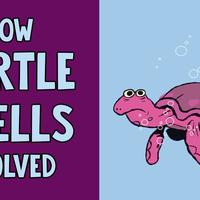How turtle shells evolved... twice - Judy Cebra Thomas
Meet Odontochelys semitestacea.
This little creature spends its days splashing in Late Triassic swamps
with a host of other reptiles.
Under the surface lies its best defense against attack:
a hard shell on its belly.
Odontochelys is an early ancestor of the turtle.
Its half-shelled body illustrates an important point about the modern turtle:
it actually has two shells that develop totally separately
while the turtle is still an embryo.
Both are extensions of the animal's skeleton,
and together they are made of almost 60 bones.
Like other embryos,
turtle embryos are made of undifferentiated cells
that become specific cell types,
and then organs and tissues,
through gene activity and communication between cells.
At first, turtle embryos look very similar to those of other reptiles,
birds, and mammals,
except for a bulge of cells called the carapacial ridge.
The ridge expands around the body between the neck and lower back,
creating a disc shape.
It guides the formation of the upper part of the turtle's shell,
called the carapace, likely by attracting the cells that will become ribs.
Instead of curving downwards to make a regular rib cage,
the ribs move outwards towards the carapacial ridge.
They then secrete a signaling protein
that converts surrounding cells into bone-forming cells.
These fifty bones grow until they meet and connect with sutures.
A ring of bone solidifies the carapace's edges.
The outer layer of skin cells produces the scales, known as scutes,
that cover the carapace.
The development of the bottom half of the shell, the plastron,
is driven by neural crest cells,
which can produce a variety of different cell types including neurons,
cartilage and bone.
A thick shield of these cells spreads across the belly,
coming together in regions that produce nine plate-like bones.
Eventually, these connect to the carapace by sutures.
A turtle's shell has obvious advantages for guarding against predators,
but the rigid casing also presents some challenges.
As the turtle grows,
the sutures between the bones of the carapace and plastron spread.
Most mammals and reptiles rely on a flexible rib cage
that expands to allow them to breathe,
but turtles use abdominal muscles attached to the shell instead:
one to breathe in, and one to breathe out.
So how did the shell evolve?
Though there are still gaps in the fossil record,
the first step seems to have been a thickening of the ribs.
The oldest known turtle ancestor,
a creature called Eunotosaurus africanus,
lived 260 million years ago and looked almost nothing like a modern turtle,
but it had a set of broad, flat ribs
that anchored the muscles of its powerful forearms.
Eunotosaurus was likely a burrowing creature,
digging homes for itself in what's now southern Africa.
Odontochelys semitestacea illustrates another, later step in turtle evolution,
with thick ribs like Eunotosaurus plus a belly plate for protection.
Our first fossil evidence of the full shell characteristic of modern turtles
is about 210 million years old,
and belongs to a species called Proganochelys quenstedti,
whose ribs had fused.
Proganochelys could move between water and land.
Unlike modern turtles, it couldn't retract its head into its shell,
but had defensive spines on its neck.
Modern turtle shells are almost as diverse as the turtles themselves.
Sea turtles have flatter, lighter shells for streamlined gliding through the water.
Land-dwelling tortoises, meanwhile,
have domed shells that can slip free of predators' jaws
and help them turn right-side up if they fall on their backs.
Leatherback and softshell turtles
have shells without the ring of bone around the edge of the carapace
or the tough scutes covering it,
making it easier for them to squeeze into tight spaces.

